
Lunar Escape Systems
Encyclopedia
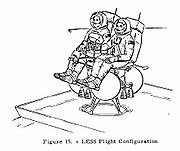
Cancelled Apollo missions
Several planned missions of the Apollo manned Moon landing program of the 1960s and 1970s were canceled for a variety of reasons, including changes in technical direction, the Apollo 1 fire, hardware delays, and budget limitations...
, the designs were never constructed.
Details
As NASA planned for longer stays on the Moon after the first few Apollo flights, they had to consider a number of new issues, one of which was what to do if you cannot get back. Typically the longer a spacecraft is idle the less reliable it becomes, so after a stay of two weeks on the Moon the Lunar ModuleApollo Lunar Module
The Apollo Lunar Module was the lander portion of the Apollo spacecraft built for the US Apollo program by Grumman to carry a crew of two from lunar orbit to the surface and back...
ascent engine or other essential systems might fail to function, leaving the astronauts stranded on the Moon without enough supplies to survive until a rescue mission could arrive from Earth.
For one possible solution NASA studied a number of low-cost, low-mass 'Lunar Escape Systems' (LESS) which could be carried on the Lunar Module as a backup, rather like a lifeboat on a ship.
'KISS
KISS principle
KISS is an acronym for the design principle Keep it simple, Stupid!. Other variations include "keep it simple and stupid", "keep it short and simple", "keep it simple sir", "keep it simple or be stupid" or "keep it simple and straightforward"...
' was the order of the day, with a few basic assumptions about any operational LESS system:
- The LESS would use fuel from the LEM ascent stage tanks, so no extra fuel would be carried on the mission.
- Rather than the multiple redundant systems used elsewhere in the Apollo program, the LESS would be as simple as possible while still achieving its mission.
- All life support would come from the astronauts' space-suit backpacks. This greatly reduced the mass and complexity of the LESS, but required that the astronauts could rendezvous with the orbiting CSM within the four-hour backpack oxygen supply.
- The LESS would support stays of up to 14 days on the lunar surface.
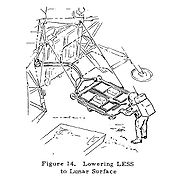
The LESS would pack flat in the side of the LEM descent stage, and arms and wires would be provided to allow controlled removal of the LESS and ensure it did not harm the astronaut who was removing it. A protective cover also doubled as a sled, so the LESS could be pushed or pulled along the ground to reach a safe launch position prior to assembly. The assembly operations were expected to take at least forty-five minutes, with a further two hours for checkout and fuelling before launch. On long-duration missions the crew might assemble the LESS early in the mission as a precaution.
Given the cut-down nature of the LESS compared to a typical spacecraft of its era, the primary differences between designs were in propulsion, guidance, navigation and control.
Propulsion
Typical LESS designs used flexible fuel tanks so that it could fold flat for storage. When the LESS was connected to the LEM ascent stage, the flexible tanks would be filled and expand to their full size ready for flight.Some LESS designs used a single engine under the center, but many used multiple engines around the edge, typically based on the Apollo reaction control system
Reaction control system
A reaction control system is a subsystem of a spacecraft whose purpose is attitude control and steering by the use of thrusters. An RCS system is capable of providing small amounts of thrust in any desired direction or combination of directions. An RCS is also capable of providing torque to allow...
(RCS) thrusters used for attitude control on the Command/Service Module
Apollo Command/Service Module
The Command/Service Module was one of two spacecraft, along with the Lunar Module, used for the United States Apollo program which landed astronauts on the Moon. It was built for NASA by North American Aviation...
(CSM) and Lunar Module
Apollo Lunar Module
The Apollo Lunar Module was the lander portion of the Apollo spacecraft built for the US Apollo program by Grumman to carry a crew of two from lunar orbit to the surface and back...
(LM or LEM). These had a thrust of around 100 lbs each, so putting eight thrusters in pairs at the corners of a square gave enough thrust to lift two astronauts to orbit.
Another benefit of the RCS-based designs was that the RCS thrusters could be fired in bursts as short as ten milliseconds, so instead of complex throttling hardware they could simply be turned on and off to adjust the average thrust over time. They could also be used to provide attitude control by varying the firing rate of different thrusters around the edge of the LESS.
Guidance
Guidance in typical LESS designs was simple: an 'eight-ball' to show spacecraft attitude, a clock to show time since liftoff, and a pre-planned pitch program. The Apollo Guidance ComputerApollo Guidance Computer
The Apollo Guidance Computer provided onboard computation and control for guidance, navigation, and control of the Command Module and Lunar Module spacecraft of the Apollo program...
used as an autopilot for the CSM and LEM had a mass of around a hundred pounds and consumed a significant amount of power, so computer controlled flight was out of the question. This would be one of the few cases where an astronaut flew a rocket manually all the way to orbit, and with far less instrumentation than normal.
The astronauts would wait until the appropriate liftoff time that would put them into an orbit close to the CSM, then launch. The pilot would attempt to hold a constant heading, and at pre-determined times during the burn he would adjust the pitch to pre-determined angles. This controlled the vertical and horizontal velocity of the LESS and consequently the orbit that it would enter: the engine would be shut down at a pre-determined time when they should have reached the correct orbit.
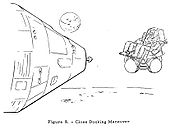
The LESS would be equipped with a flashing light and VHF radio beacon to simplify tracking from the CSM. On reaching the rendezvous point the CSM pilot would dock with the LESS using the same docking probe that was used to dock with the LEM, and a special attachment on the front of the LESS. This would require some skilled flying on the part of the pilot, as any use of the front-facing RCS jets could present a serious hazard to the astronauts on the LESS if the hot exhaust gases hit them.
Once docked the CSM pilot would depressurise the Command Module and open the hatch to space, so the astronauts on the LESS could use the external hand-holds on the Command Module to crawl to the hatch and climb inside. The crew would then separate the CSM from the LESS and leave it in lunar orbit when they returned to Earth.
Navigation
There was no mass or power available in the LESS for an Inertial Measurement UnitInertial measurement unit
An inertial measurement unit, or IMU, is an electronic device that measures and reports on a craft's velocity, orientation, and gravitational forces, using a combination of accelerometers and gyroscopes. IMUs are typically used to maneuver aircraft, including UAVs, among many others, and...
to measure acceleration and tell the astronauts where they were, where they were going or how fast they would be getting there, or even for a radar altimeter to show altitude above the lunar surface.
In deep space this would have made navigation difficult, but fortunately the astronauts were close to the lunar surface, so other options were available. Most plans called for the astronauts to use landmarks on the lunar surface to control their heading while the pitch program took care of altitude and velocity. By keeping the landmark in the correct position relative to the LESS, they would know they were on the right course. Some designs included a graduated screen in front of the pilot showing relative angle to lunar landmarks.
Control
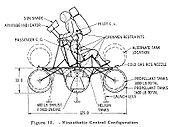
For the true 'seat of the pants' feeling, however, the simplest designs had no attitude control system at all. Instead the pilot would stand during the flight, and simply lean backwards, forwards or side-to-side to move the center of gravity relative to the center of thrust of the fixed engine. As a result the offset thrust would cause the LESS to rotate until the astronaut returned to a neutral position and the center of gravity was again aligned with the engine thrust. Ultimately, however, this was considered to be less desirable than hardware control, particularly as it imposed significant constraints on vehicle thrust level and inertia... adding gimballing or relative engine throttling might actually simplify the design.
Long-Range Flyer
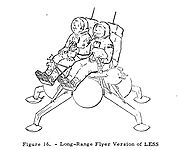
Lunar rover
The Lunar Roving Vehicle or lunar rover was a battery-powered four-wheeled rover used on the Moon in the last three missions of the American Apollo program during 1971 and 1972...
allowed the astronauts to travel fairly quickly over a few miles, but an improved version of the LESS could allow rapid travel over much longer distances on rocket thrust.
By adding fixed legs, increasing structural strength to support landing stresses, supporting engine throttling or using a cluster of RCS engines that could be pulsed, and adding a long-range radio relay, the LESS design could be extended to become a long-range flyer (LRF). With around 1600 pounds of propellant from the LEM, the astronauts could travel forty to sixty nautical miles from the LEM to explore a wider area around the landing site. This would, for example, allow reconnaissance trips to potential future landing sites, and the LRF could also be used for orbital flight to return the crew to the CSM in an emergency.

